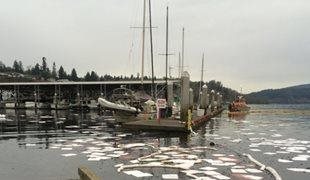In 2016, the Tyee Marina fire in Tacoma and the Port Orchard Yacht Club fire each had a leg up because local emergency responders had a stash of state-funded oil spill response equipment nearby to quickly deploy while Ecology spill responders headed their way.
Responders to the 2016 Mosier, Ore., oil train derailment also got a boost because the Yakama Nation had a cache of state-funded spill response equipment stored nearby.
Not all spill incidents have this good fortune. When an oil spill happens, the nearest response equipment may be hours away.
The 11 grants totaling $333,500 will provide local emergency response organizations the money to purchase equipment they need to respond to oil spills, hazardous materials and fires. The funding program is directed by the state’s Oil Transportation Safety Act.
Grant recipients
- Cowlitz County Fire District #1: $20,000 for gas detectors and accessories.
- Quileute Tribe: $10,000 to replace their original spill response equipment cache trailer.
- Quinault Indian Nation: $11,000 for trailer tires, training, and spill response kits.
- Seattle Fire Department: $85,000 to purchase firefighting foam totes.
- South Kitsap Fire and Rescue: $30,000 for a spill response equipment cache trailer.
- South Pend Oreille Fire and Rescue: $2,500 to purchase safety equipment.
- Stevens County Fire Protection District 12: $30,000 for gas detectors, radios, and oil containment boom.
- Swinomish Indian Tribal Community: $30,000 for a spill response equipment cache trailer.
- Tulalip Tribes: $30,000 for oil containment boom and a trailer.
- Vancouver: $40,000 for a trailer to transport firefighting foam.
- Yakima County Fire District 6: $45,000 for bunker (oil transfer protection) gear.
Ecology selected these 11 grants during the 2015-17 grant process, identifying them as funding priorities under the current state budget. Ecology accepted applications for additional oil and hazardous materials equipment through Nov. 30, 2017. Those applications are currently being evaluated for future grant funding, which is expected when the state finalizes its supplemental budget in 2018.
Read more about Ecology’s grant program online and see a map of where the equipment caches are located.


